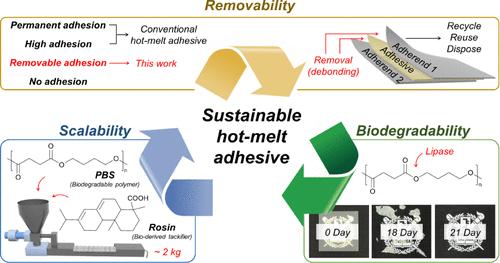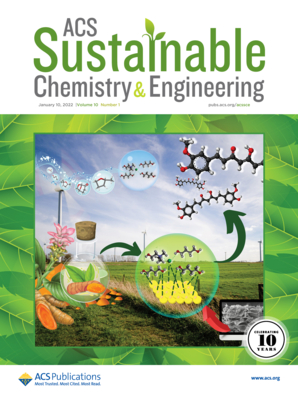实现具有生物降解性、可扩展性和可去除性的可持续粘合剂:聚丁二酸丁二醇酯热熔胶
IF 7.1
1区 化学
Q1 CHEMISTRY, MULTIDISCIPLINARY
引用次数: 0
摘要
以往旨在实现粘合剂材料可持续性的研究主要集中在生物衍生或生物降解成分的整合上。然而,现有的可持续粘合剂通常优先考虑永久粘合性,而非可拆卸性,这限制了它们的可回收性。在此,我们介绍一种创新方法,用于生产可扩展、可生物降解和可拆卸的热熔粘合剂,并提供可持续性。我们选择聚丁二酸丁二醇酯(PBS)作为基础聚合物,因为它具有出色的熔融加工性、生物降解性和商业可用性。为了增强粘合力,还加入了三种生物质增粘剂:碱性松香、歧化松香和松香酯。使用双螺杆挤出机可以高效地混合基础聚合物和增粘剂,从而实现公斤级的大规模生产。我们的研究表明,碱性松香具有最佳的相容性和润湿性,这要归功于它的高酸值。高酸值促进了快速结晶,并最大程度地减少了晶体缺陷。此外,还建立了结晶行为与粘附强度之间的相关性,从而确定了最佳成分。最佳成分可产生令人满意的粘附强度(2.5 牛顿/25 毫米),使其适用于可移除或可重新定位的粘合剂。此外,我们优化的粘合剂具有足够的生物降解性,在 21 天内就能被脂肪酶完全分解,这在以往的可持续热熔粘合剂研究中是没有观察到的。这项研究为提高粘合剂的可持续性提供了一条实用的途径,并有可能在未来的研究中进一步提高粘合强度,以适应不同的应用。本文章由计算机程序翻译,如有差异,请以英文原文为准。

Toward Sustainable Adhesives with Biodegradability, Scalability, and Removability: Poly(butylene succinate)-Based Hot-Melt Adhesives
Previous studies aiming to achieve sustainability in adhesive materials, primarily focused on the integration of bioderived or biodegradable components. However, existing sustainable adhesives often prioritize permanent adhesion over removability, which limits their recyclability. Herein, we introduce an innovative approach for producing scalable, biodegradable, and removable hot-melt adhesives, offering sustainability. Polybutylene succinate (PBS) was selected as the base polymer because of its excellent melt processability, biodegradability, and commercial availability. To impart adhesiveness, three biomass-derived tackifiers were incorporated; basic rosin, disproportionated rosin, and rosin ester. The use of a twin-screw extruder enabled the efficient mixing of the base polymer and tackifiers for large-scale production at the kilogram scale. Our investigation revealed that basic rosin exhibited optimal compatibility and wettability, which were attributed to its high acid value. The high acid value promoted rapid crystallization and minimized crystal defects. A correlation between the crystallization behavior and adhesion strength was also established, identifying the optimal composition. The optimal composition yields a satisfactory adhesion strength (2.5 N/25 mm) that makes it suitable for removable or repositionable adhesives. Additionally, our optimized adhesive exhibited sufficient biodegradability and was completely decomposed by lipase within 21 d, which has not been observed in previous sustainable hot-melt adhesive studies. This study provides a practical pathway for enhancing adhesive sustainability with the potential for further advancements in tailoring the adhesion strength for diverse applications in future research.
求助全文
通过发布文献求助,成功后即可免费获取论文全文。
去求助
来源期刊

ACS Sustainable Chemistry & Engineering
CHEMISTRY, MULTIDISCIPLINARY-ENGINEERING, CHEMICAL
CiteScore
13.80
自引率
4.80%
发文量
1470
审稿时长
1.7 months
期刊介绍:
ACS Sustainable Chemistry & Engineering is a prestigious weekly peer-reviewed scientific journal published by the American Chemical Society. Dedicated to advancing the principles of green chemistry and green engineering, it covers a wide array of research topics including green chemistry, green engineering, biomass, alternative energy, and life cycle assessment.
The journal welcomes submissions in various formats, including Letters, Articles, Features, and Perspectives (Reviews), that address the challenges of sustainability in the chemical enterprise and contribute to the advancement of sustainable practices. Join us in shaping the future of sustainable chemistry and engineering.
 求助内容:
求助内容: 应助结果提醒方式:
应助结果提醒方式:


